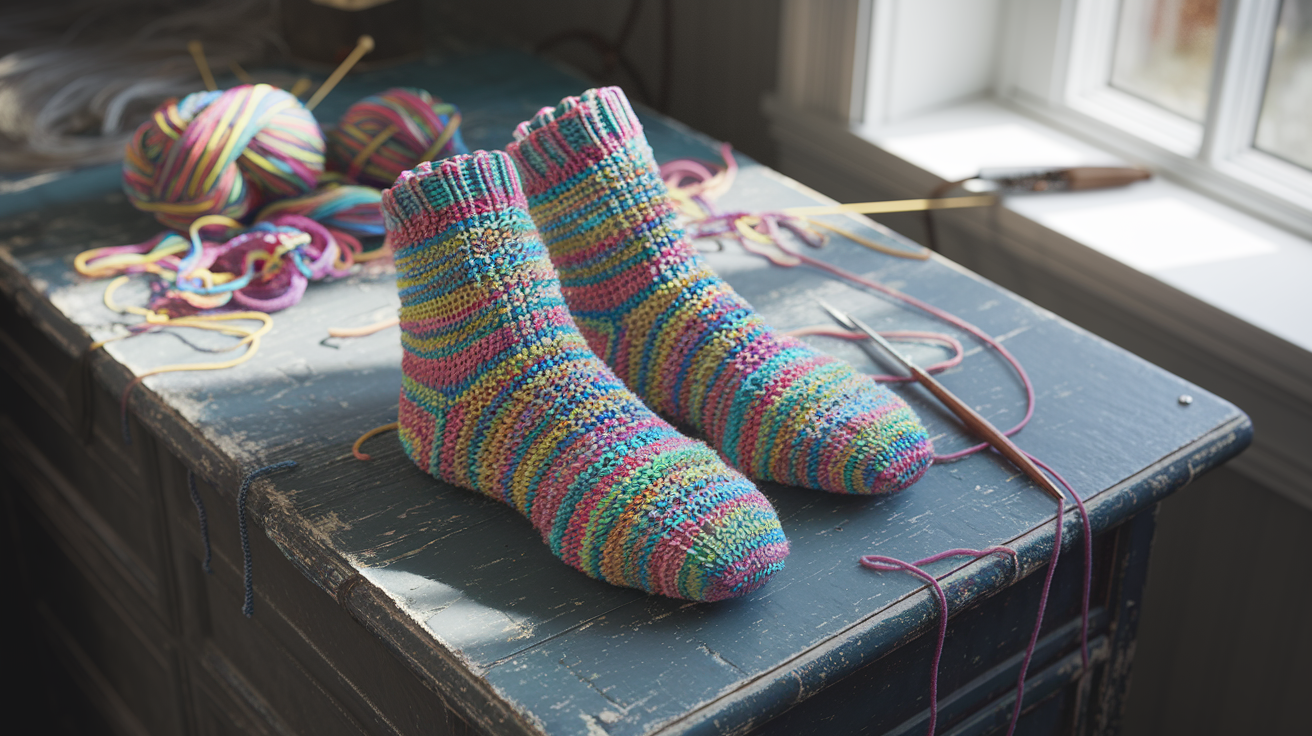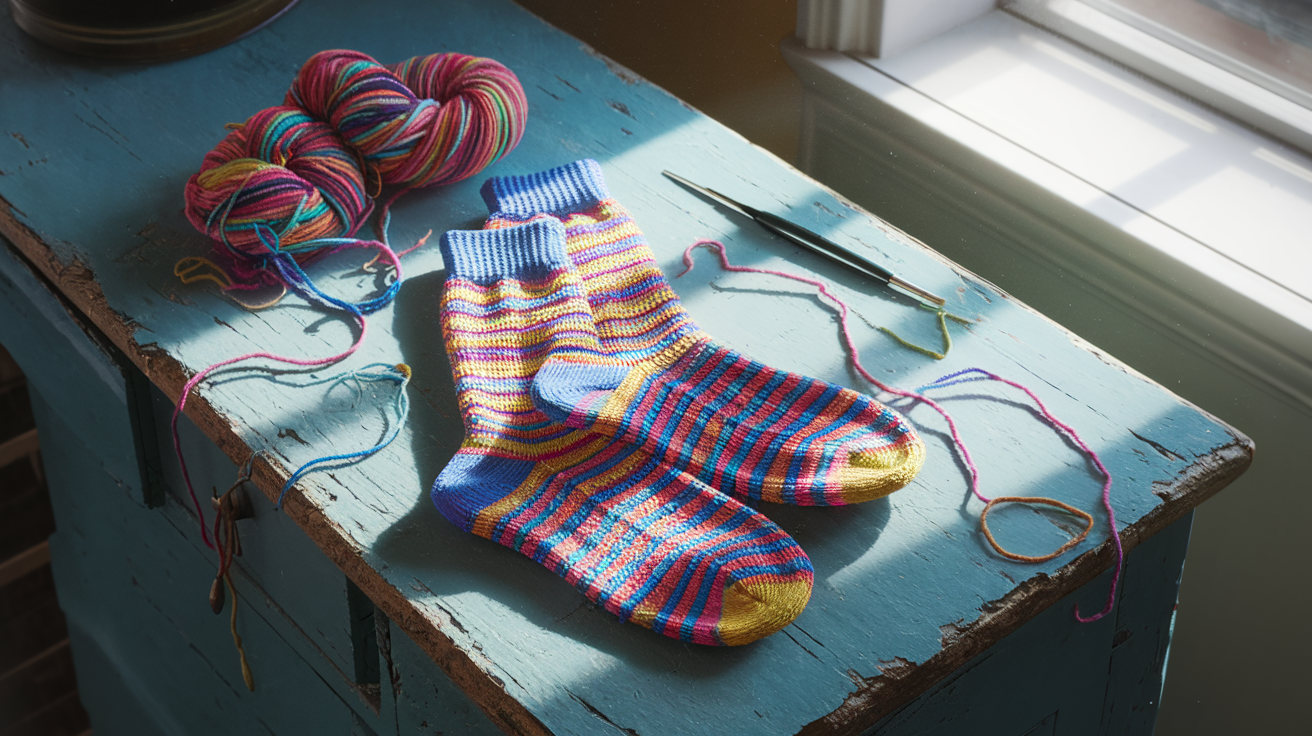How To Knit Super Fun Colorwork Socks For Beginners

Vibrant hues and bold patterns spark creativity when you transform simple yarn into playful colorwork socks—the perfect project for any craft-loving beginner. Colorwork socks use easy approaches like stripes and geometric motifs, ideal for building fiber arts skills and crafting personalized designs.
Beginner knitting projects shine when you master two-color knitting or stranded knitting, using knitting tips such as holding one yarn in each hand for smooth transitions.
Place stitch markers as you knit in the round to track pattern repeats, and follow chart reading basics for flawless motif placement.
Enjoy exploring fun yarn color combinations and unlock your creative knitting potential as each round reveals another splash of wearable art.
Choosing the Perfect Sock Yarn
Sock yarn selection forms the essential foundation for knitting socks that are both comfortable and resilient. Fiber composition matters—look for blends with merino wool and nylon for elasticity and long-lasting colorwork socks.
Yarn weight also impacts stitch definition; fingering weight works best for clear patterns and manageable needle size. Washability is key, so seek machine-washable or superwash-treated yarns for practical everyday wear.
Check fiber percentages on each label to balance beauty and durability—75% wool and 25% nylon is a solid starting point.
Begin your beginner knitting journey with high-quality sock yarn for confident, successful results.
Fiber Composition for Durability
Yarn selection for your colorwork socks should prioritize durability, ensuring your handmade items withstand regular wear.
Merino wool provides softness and warmth, while nylon adds essential elasticity and strength. This blend is ideal for knitting socks that keep their shape and resist wear.
Consider yarn crafted from natural fibers like merino wool for a luxurious feel; these often come from sustainable yarns or ecofriendly yarns. For beginner knitting, a good mix of wool and nylon creates a forgiving yet sturdy fabric.
Understanding Yarn Weight and Stitch Definition
Yarn weight significantly influences the appearance of your colorwork socks and the ease of chart reading.
Fingering weight yarn, often used for knitting socks, provides excellent stitch definition, allowing intricate geometric motifs and repeating patterns to stand out clearly.
This weight also works well with smaller needle sizes, creating a denser fabric that prevents dreaded floats from showing too much and aids in maintaining even tension.
When selecting sock yarn, check the label for recommended needle sizes to achieve the best results for your
colorwork techniques.
Washability: A Practical Consideration
Sock yarn that is easy to care for makes your DIY socks a joy to wear and maintain. Washability is a significant factor when choosing yarn for knitting socks, especially for beginners who want their creations to last.
Look for yarns labeled superwash or those explicitly stating they are machine washable. This ensures your beautiful personalized socks can be enjoyed frequently without the hassle of handwashing.
Choosing practical sock yarn supports your creative hobbies and makes your craft projects more sustainable.
Checking Fiber Blend Percentages
Sock yarn selection involves paying attention to the fiber blend percentages on the label to balance aesthetic appeal with practical wearability for your colorwork socks.
A common and highly recommended blend for knitting socks is 75% wool (often merino wool) and 25% nylon.
This combination offers the warmth and softness of wool with the added resilience and elasticity of nylon, making these knit charts easier to follow and the resulting socks more durable. This blend is a fantastic starting point for anyone new to beginner knitting.

Mastering Beginner Knitting Techniques
Beginner knitting involves building upon basic cast-on and knit stitches, making each stitch even and consistent. Achieving even tension is key for crafting fabric that feels smooth and professional, especially when working with sock yarn for your colorwork socks.
Practice holding your yarn in a way that feels natural and allows for uniform stitches to prevent puckering across the fabric.
Using stitch markers helps immensely by marking the beginning of rounds and separating pattern sections, ensuring you keep your place when you knit in the round, whether using circular needles or double-pointed needles.
For those ready to tackle a simple beginner project, a ribbed cuff sock is an excellent starting point, offering the flexibility to incorporate a few colorwork rounds as your confidence grows. This solid foundation prepares you for more advanced sock patterns and techniques, enhancing your overall knitting journey.
Exploring Easy Colorwork Sock Patterns
Colorwork socks open up a world of creative knitting, allowing you to introduce playful designs and bold patterns through approachable techniques like stranded knitting.
Effective yarn management is essential when you’re dealing with multiple yarns; try holding one yarn in each hand or alternating fingers to keep both strands tangle-free and facilitate smooth color changes. Knit charts provide a roadmap for pattern interpretation—read them from right to left, always referencing the symbol key for each color repeat as you knit in the round.
To begin, select beginner sock patterns that feature just two contrasting colors, perfect for creating playful designs such as simple stripe patterns or easy geometric motifs.
To preserve the elasticity of your knitted socks, it’s important to catch floats, which are the sections of yarn carried on the inside of your work, by twisting the yarn every 2–3 stitches as you progress across rounds.
This prevents the fabric from becoming too tight or snagging. The goal is to achieve vibrant hues and comfortable, personalized socks for every creative hobbyist.
- Achieving even tension is crucial for creating smooth, professional-feeling knitted fabric, especially when using sock yarn for colorwork.
- Stitch markers are helpful for marking the beginning of rounds and separating pattern sections when knitting in the round.
- Stranded knitting is an approachable technique for introducing playful designs and bold patterns in colorwork socks.
- Catching floats by twisting yarn every 2-3 stitches helps preserve the elasticity of knitted socks and prevents snagging.
Mastering Stranded Knitting for Socks
Colorwork socks open up a world of creative designs, and mastering stranded knitting is your key to unlocking them. Begin by selecting contrasting sock yarn for those vibrant hues that make your projects pop.
For beginner knitting success, a reliable gauge is paramount—always check your gauge with multiple yarns by swatching before you start your chosen sock pattern.
Improving yarn management is made easier by weaving in ends as you go; each new color section presents an opportunity to refine those tails for a neater, more professional finish.
To effectively control float length, which is the yarn carried on the inside of your work, you can intentionally twist the yarns together every few stitches. This practice helps keep floats relaxed, preventing snagging or undue tightness, and consequently ensures a comfortable, stretchy fit for your finished socks.
Knitting tips for managing multiplecolor knitting include learning to manage two yarns at once, perhaps by using one in each hand or alternating fingers for smoother color changes.
This helps with even tension and stitch consistency. Consider knitting socks inside-out for neater floats and a smoother interior surface.
Using stitch markers is also helpful to track round beginnings and pattern repeats, adding to your crafting advice.
Try out jogless joins techniques to minimize visible gaps where new rounds commence, especially with stripe patterns.
Experimenting with bold or unexpected color combinations can result in uniquely personal socks, fostering creative knitting.
Reading Knit Charts Made Simple
Knit charts are your visual roadmap, essential for understanding pattern interpretation in colorwork socks.
These charts associate specific symbols with stitches and colors, providing a clear visual representation of your design. To maintain accuracy, it’s helpful to track your progress directly on the chart, highlighting completed rows as you go.
This methodical approach ensures you stay aligned with the intricate design, making even complex sock patterns feel more approachable techniques.
This straightforward method helps beginners with chart reading and ensures you stay on pattern while enjoying vibrant multiplecolor knitting.
Knitting tutorials often suggest that reading charts from right to left, following each symbol, is key to keeping patterns accurate.
This is a fundamental aspect of chart reading for stranded knitting and fair isle knitting. Don’t pull the carried yarn too tight—loose floats are better for the overall fit and comfort of your knit socks.
Blocking finished socks will even out stitches and help set the pattern, enhancing the beauty of your bold patterns and playful designs. Knitting inspiration can come from anywhere; experiment and have fun! Colorwork allows for endless creative options, leading to beautifully personalized socks.
- Checking your gauge with multiple yarns before starting a sock pattern is paramount for beginner knitting success.
- Intentionally twisting yarns together every few stitches helps control float length, preventing snagging and ensuring a comfortable fit.
- Reading knit charts from right to left, following each symbol, is a key technique for maintaining accuracy in stranded and Fair Isle knitting.
- Blocking finished socks helps even out stitches and set the pattern, enhancing the overall look of bold and playful designs.
Managing Multiple Yarns Effectively
Colorwork socks bring dynamic energy to your knitting, but handling more than one yarn need not lead to chaos. Yarn management techniques help you create vibrant hues and bold patterns with ease.
Fortwocolor knitting, holding one yarn in each hand is a popular method for efficient color changes, greatly reducing tangles as each strand stays on its own side of your work.
Stranded knitting calls for close attention to tension; try the drop-and-pick-up method or use yarn bobbins to keep strands organized and prevent knotting.
Knitting socks seamlessly is easier when you rotate your working yarns in the same direction consistently. When you need to add a new yarn ball, simply overlap the ends with a few stitches to minimize bulk, allowing for a smooth transition.
Colorwork techniques such as catching floats regularly not only secure your fabric but also keep the inside smooth and wearable, a key aspect of fair isle knitting.
Tips for Yarn Tension Control
Achieving even fabric is the secret ingredient for beautifully balanced colorwork socks that both fit well and showcase bold designs. Yarn tension plays a direct role in achieving flat, non-puckering fabric; be mindful of your knitting speed and relax your grip if stitches get tight.
Beginner knitting often benefits from consciously adjusting hand placement as you work through a project; don’t hesitate to pause and test your grip.
Experiment with different sock yarn types to understand how each fiber responds—wool, cotton, and blends vary in stretch and how they handle floats.
Practice with various yarn weights and aim for a smooth, continuous flow to master the art of stranded knitting tension, enhancing the beauty of geometric motifs and repeating patterns.
- Holding one yarn in each hand is a popular method for efficient color changes in two-color knitting, reducing tangles by keeping strands on their own sides.
- Techniques like the drop-and-pick-up method or using yarn bobbins are recommended for stranded knitting to keep strands organized and prevent knotting.
- Rotating working yarns in the same direction consistently and overlapping new yarn ends with a few stitches helps in knitting socks seamlessly and minimizing bulk.
- Consciously adjusting hand placement and relaxing your grip are beneficial for beginner knitting to achieve even fabric and control yarn tension, preventing puckering.
Creating Vibrant Hues in Knitting
Knitters exploring the world of colorwork socks often delve into the fascinating realm of yarn dye processes, such as immersion dyeing, kettle dyeing, or hand painting, each offering distinct avenues to achieve vivid, enduring shades. Sock yarn that is expertly dyed provides not only visual brilliance but also ensures colorfastness and a pleasing texture for your handmade creations, making every stitch count.
Knitting socks using high-contrast colors will readily produce standout patterns and playful effects in every stitch, ensuring your project is truly one-of-a-kind and a testament to your craft skills.
Experimenting with gradient yarns introduces effortless color transitions and intriguing visual movement, readily adding depth to your socks without requiring complicated techniques and enhancing your creative knitting.
For beginner knitting, incorporating strategic color blocking—that is, using generous swaths of complementary or bold hues—can simplify pattern reading while delivering modern, graphic impact that is both eye-catching and approachable. Creative knitters are strongly encouraged to explore hand-dyed and variegated yarns for boundless inspiration, transforming each pair into a wearable statement of individual style and a representation of textile design.
Stranded knitting, a popular method, allows for intricate designs by carrying two or more colors across the wrong side of your work. Fair isle knitting, a specific type of stranded knitting, is renowned for its traditional motifs and vibrant color palettes that are both beautiful and culturally rich.
Knit charts are essential tools for following complex colorwork designs, ensuring accuracy and neatness in your stitches.
Yarn management techniques are key for success, preventing tangles and ensuring even tension throughout your project, which contributes to the overall quality of your handmade items.
Sock patterns often feature unique stitch combinations that enhance the visual appeal and texture of the finished product. Twocolor knitting is an excellent starting point for those new to colorwork, offering a simpler way to introduce contrasting colors.
Multiplecolor knitting expands the possibilities further, allowing for more complex and layered designs, perfect for showcasing artistic knitting. Yarn tension must be kept consistent when working with multiple colors to avoid puckering or overly tight stitches, a common pitfall for beginners.
Float catching, the practice of periodically securing the carried yarn on the back of your work, is a vital skill to maintain the fabric’s stretch and prevent snags.
Chart reading skills are paramount for accurately interpreting the symbols and color changes indicated on a knitting chart.
Pattern interpretation is essential to understand the stitch counts and sequences required for a successful outcome. Color contrast is important for making your designs pop, so choose hues that stand out against each other for maximum impact.
Vibrant hues add life and energy to any knitting project, making your creations truly eye-catching. Bold patterns, such as geometric motifs or animal designs, can make a strong statement and showcase your personal flair.
Playful designs inject fun and personality into your knitting, encouraging creativity and experimentation with different motifs.
Geometric motifs offer a clean and modern aesthetic, easily adaptable to various color combinations and repeating patterns.
Stripe patterns are a classic choice for colorwork, providing a simple yet effective way to introduce multiple colors into your knitting. Repeating patterns create a mesmerizing effect and can be adapted to fit the size of your project with ease.
Custom motifs allow you to express your unique style and create truly personalized socks that reflect your interests and personality. Yarn selection is a foundational step, with merino wool being a popular choice for its softness and warmth, ideal for comfortable everyday wear.
Needle size plays a significant role in achieving the correct gauge and fabric density, typically smaller needles are used for sock knitting to create a firm fabric.
Circular needles are commonly used for knitting socks in the round, offering a flexible and convenient way to work.
Double-pointed needles are another option for sock knitting, providing more control for smaller circumferences. Magic loop is a technique that uses a long circular needle to knit small circumference items, offering a seamless knitting experience.
Knit in the round creates a seamless tube, eliminating the need
| Yarn Properties | Knitting Techniques | Design Elements |
|---|---|---|
| Vivid, enduring shades from immersion or kettle dyeing | Stranded knitting for intricate designs | High-contrast colors for standout patterns |
| Colorfastness and pleasing texture | Fair Isle knitting for traditional motifs | Gradient yarns for effortless color transitions |
| Merino wool for softness and warmth | Twocolor knitting for beginners | Color blocking for modern, graphic impact |




